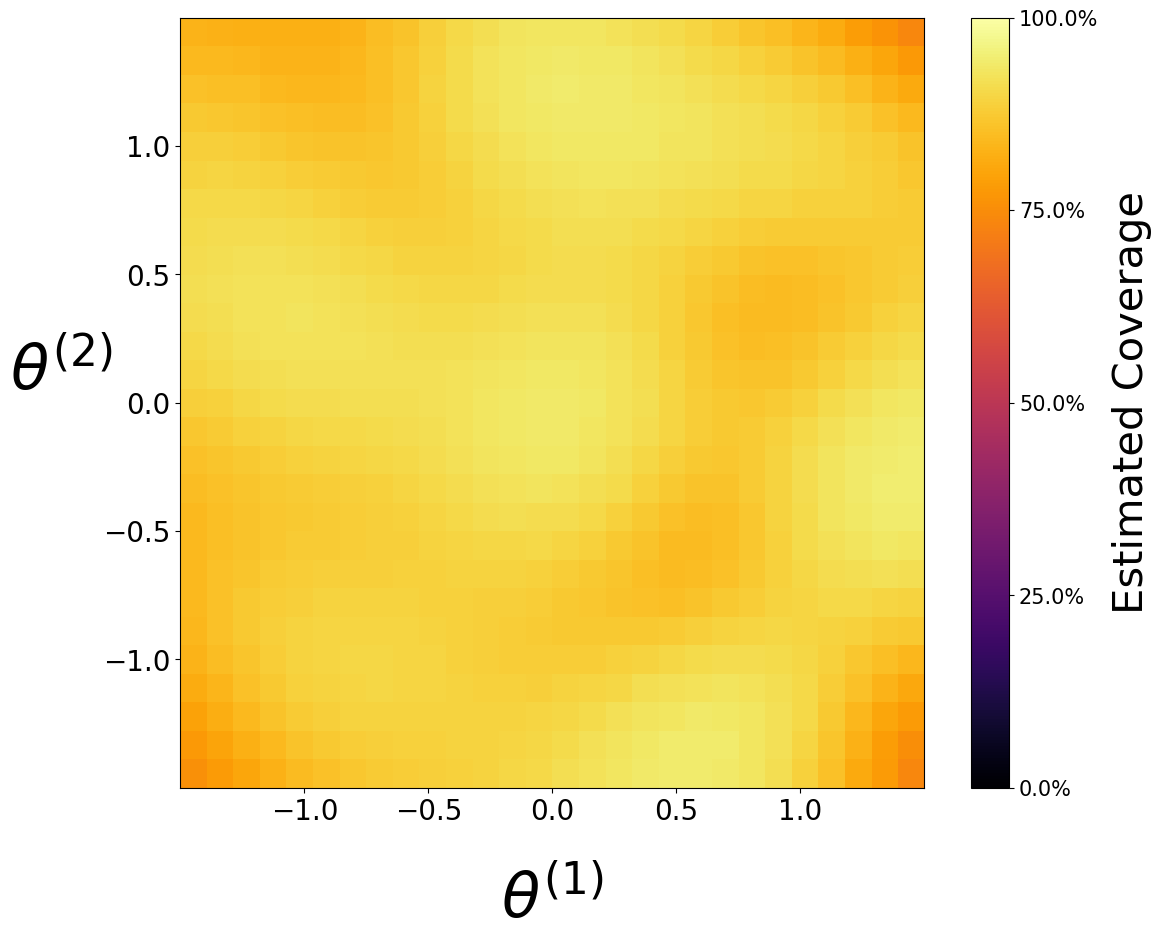Confidence Regions from Posterior Estimators#
INTRO & SETTINGS#
The goal of this tutorial is to show the capabilities of lf2i and Waldo with a simple example: inferring the mean \(\theta \in \mathbb{R}^{2}\) of a Gaussian model with fixed covariance, and a Gaussian prior distribution
In addition, we assume that we only observe one sample for each true \(\boldsymbol{\theta}\), i.e., \(n=1\).
For this tutorial, we leverage a posterior estimator (NPE) as the main underlying inferential model.
# SETTINGS
LIKELIHOOD_COV = 0.01
PRIOR_LOC = 0
PRIOR_COV = 0.1
PARAM_DIM = 2
DATA_DIM = 2
BATCH_SIZE = 1 # assume we get to see only one observed sample for each “true” parameter
PARAM_SPACE_BOUNDS = {'low': -1.5, 'high': 1.5} # a grid of points over [low, high]^(param_dim) is used to construct confidence sets
CONFIDENCE_LEVEL = 0.90
SIMULATE#
Let’s start from the simulator, which is used internally to generate the data needed to
estimate the test statistics;
estimate the critical values; and
diagnose the constructed confidence regions
from lf2i.simulator.gaussian import GaussianMean
simulator = GaussianMean(
likelihood_cov=LIKELIHOOD_COV,
prior='gaussian',
poi_space_bounds=PARAM_SPACE_BOUNDS,
poi_grid_size=10_000,
poi_dim=PARAM_DIM,
data_dim=DATA_DIM,
batch_size=BATCH_SIZE,
prior_kwargs={'loc': PRIOR_LOC, 'cov': PRIOR_COV}
)
Observations#
For simplicity, let’s use the simulator to generate two “observed” samples from the true likelihood: one consistent with the prior (\(\boldsymbol{\theta}^{\star} = [0, 0]\)) and one not (\(\boldsymbol{\theta}^{\star} = [-1.45, 1.45]\))
import torch
true_param_consistent, true_param_notconsistent = torch.Tensor([0, 0]), torch.Tensor([-1.45, 1.45])
observed_x_consistent = simulator.likelihood(true_param_consistent).sample(sample_shape=(BATCH_SIZE, ))
observed_x_notconsistent = simulator.likelihood(true_param_notconsistent).sample(sample_shape=(BATCH_SIZE, ))
CONFIDENCE SET by leveraging a POSTERIOR ESTIMATOR#
Assume we want to do inference on the Gaussian mean by estimating its posterior distribution. Waldo allows to leverage a neural posterior estimator like NPE to obtain a confidence region for the parameter of interest that is guaranteed to have the desired level of coverage regardless of
the consistency of the prior distribution with the data;
the true value of the parameter;
the size of the observed sample
The posterior estimator can be already trained or not. The example below assumes the estimator has not been trained yet
from lf2i.inference import LF2I
from lf2i.utils.other_methods import hpd_region
from lf2i.plot.parameter_regions import plot_parameter_region
lf2i = LF2I(
test_statistic='waldo',
poi_dim=PARAM_DIM,
estimation_method='posterior',
estimator='snpe',
num_posterior_samples=20_000 # used to approximate conditional mean and variance of the Waldo test statistic
)
Note that for this example we are using the simulator to obtain training datasets. If one has pre-simulated datasets, they can be given as inputs directly to the inference method.
confidence_region = lf2i.inference(
x=torch.vstack((observed_x_consistent, observed_x_notconsistent)),
evaluation_grid=simulator.poi_grid,
confidence_level=CONFIDENCE_LEVEL,
simulator=simulator,
b=20_000, b_prime=10_000,
re_estimate_critical_values=True
)
Estimating test statistic ...
Neural network successfully converged after 57 epochs.
Estimating critical values ...
Approximating conditional mean and covariance for 10000 points...: 100%|██████████| 10000/10000 [08:03<00:00, 20.68it/s]
Fitting 5 folds for each of 10 candidates, totalling 50 fits
Constructing confidence regions ...
Approximating conditional mean and covariance for 2 points...: 100%|██████████| 2/2 [00:00<00:00, 6.64it/s]
Waldo Confidence Region
# The red star in the plot is the true parameter
plot_parameter_region(
parameter_region=confidence_region[0],
param_dim=PARAM_DIM,
true_parameter=true_param_consistent,
param_names=['theta0', 'theta1'],
parameter_space_bounds={'theta0': simulator.poi_space_bounds, 'theta1': simulator.poi_space_bounds},
alpha_shape=True, # contour,
alpha=2, # hyperparameter for contour (the lower, the more it converges to a convex hull)
scatter=False, # don't plot evaluation points
figsize=(7.5, 7.5),
region_name='LF2I confidence set'
)
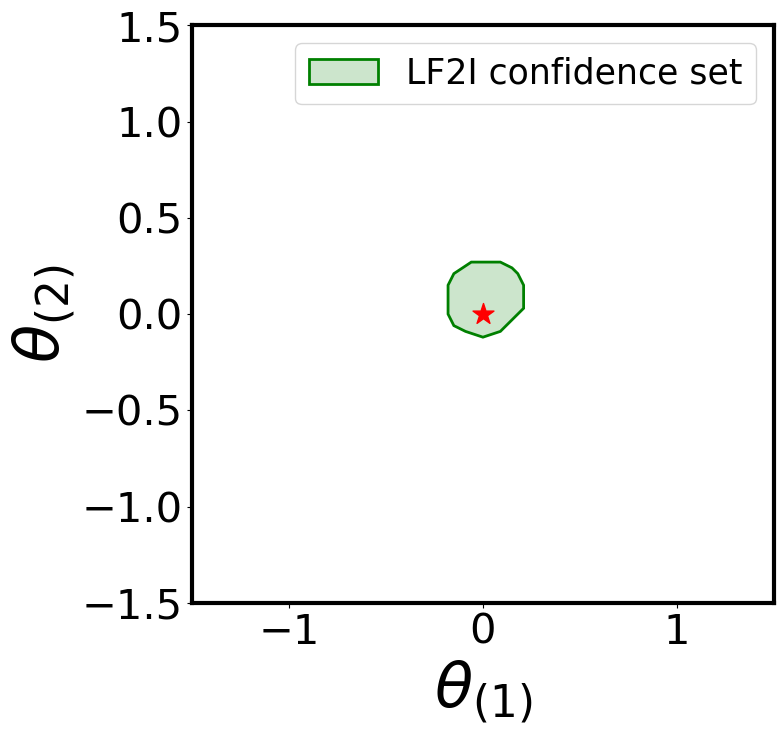
Posterior Credible Region
plot_parameter_region(
parameter_region=hpd_region(
posterior=lf2i.test_statistic.estimator,
param_grid=simulator.poi_grid,
x=observed_x_consistent,
confidence_level=CONFIDENCE_LEVEL
)[1],
param_dim=PARAM_DIM,
true_parameter=true_param_consistent,
param_names=['theta0', 'theta1'],
parameter_space_bounds={'theta0': simulator.poi_space_bounds, 'theta1': simulator.poi_space_bounds},
alpha_shape=True, # contour,
alpha=2, # hyperparameter for contour (the lower, the more it converges to a convex hull)
scatter=False, # don't plot evaluation points
figsize=(7.5, 7.5),
color='blue',
region_name='Posterior credible set'
)
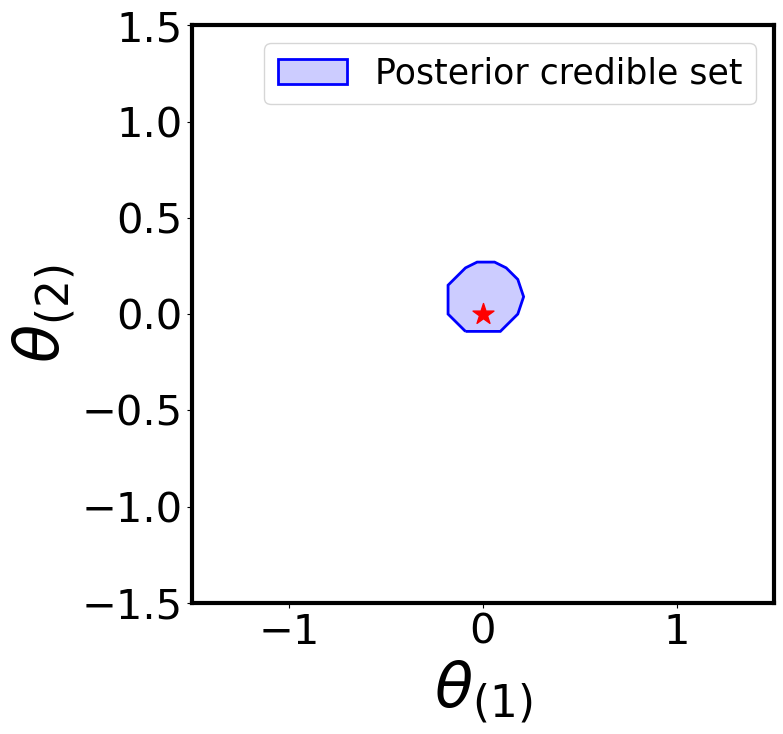
Waldo Confidence Region
plot_parameter_region(
parameter_region=confidence_region[1],
param_dim=PARAM_DIM,
true_parameter=true_param_notconsistent,
param_names=['theta0', 'theta1'],
parameter_space_bounds={'theta0': simulator.poi_space_bounds, 'theta1': simulator.poi_space_bounds},
alpha_shape=True, # contour,
alpha=2, # hyperparameter for contour (the lower, the more it converges to a convex hull)
scatter=False, # don't plot evaluation points
figsize=(7.5, 7.5),
region_name="LF2I confidence set"
)

Posterior Credible Region
plot_parameter_region(
parameter_region=hpd_region(
posterior=lf2i.test_statistic.estimator,
param_grid=simulator.poi_grid,
x=observed_x_notconsistent,
confidence_level=CONFIDENCE_LEVEL
)[1],
param_dim=PARAM_DIM,
true_parameter=true_param_notconsistent,
param_names=['theta0', 'theta1'],
parameter_space_bounds={'theta0': simulator.poi_space_bounds, 'theta1': simulator.poi_space_bounds},
alpha_shape=True, # contour,
alpha=2, # hyperparameter for contour (the lower, the more it converges to a convex hull)
scatter=False, # don't plot evaluation points
figsize=(7.5, 7.5),
color='blue',
region_name="Posterior credible set"
)
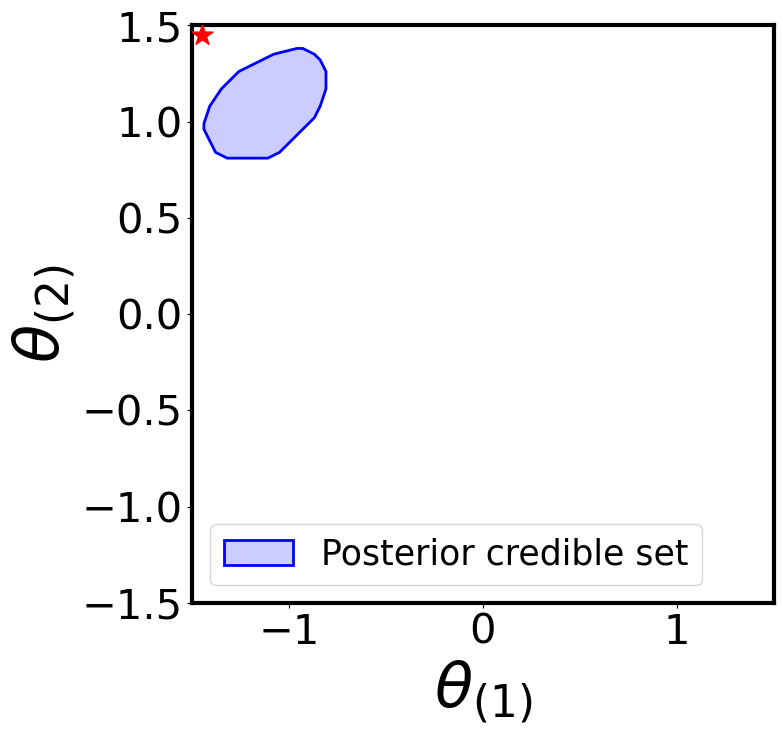
DIAGNOSTICS#
from lf2i.plot.coverage_diagnostics import coverage_probability_plot
Posterior Credible Regions#
Note that for this example we are using the simulator to obtain training datasets. If one has pre-simulated datasets, they can be given as inputs directly to the inference method.
# this will take a few minutes because it has to compute a HPD credible region for each pair of (theta, x) in the simulated set
# the code is parallelied, but one can make it faster by decreasing the argument num_p_levels, which controls the number of level sets examined to construct the HPD region
# note that this might cause the credibility level of the HPD region to be only approximately equal to CONFIDENCE LEVEL
diagnostic_estimator, parameters, mean_proba, upper_proba, lower_proba = lf2i.diagnostics(
region_type='posterior',
simulator=simulator,
b_double_prime=10_000,
evaluation_grid=simulator.poi_grid.reshape(-1, PARAM_DIM),
confidence_level=CONFIDENCE_LEVEL,
posterior_estimator=lf2i.test_statistic.estimator
)
Computing indicators for 10000 credible regions: 100%|██████████| 10000/10000 [11:54<00:00, 14.00it/s]
Coverage of posterior credible regions can be very erratic: they tend to overcover close to the “bulk” of the prior and severely undercover far from it. The correct level here is 90%
coverage_probability_plot(
parameters=parameters,
coverage_probability=mean_proba,
upper_proba=None,
lower_proba=None,
confidence_level=CONFIDENCE_LEVEL,
param_dim=PARAM_DIM,
figsize=(10, 8.2)
)
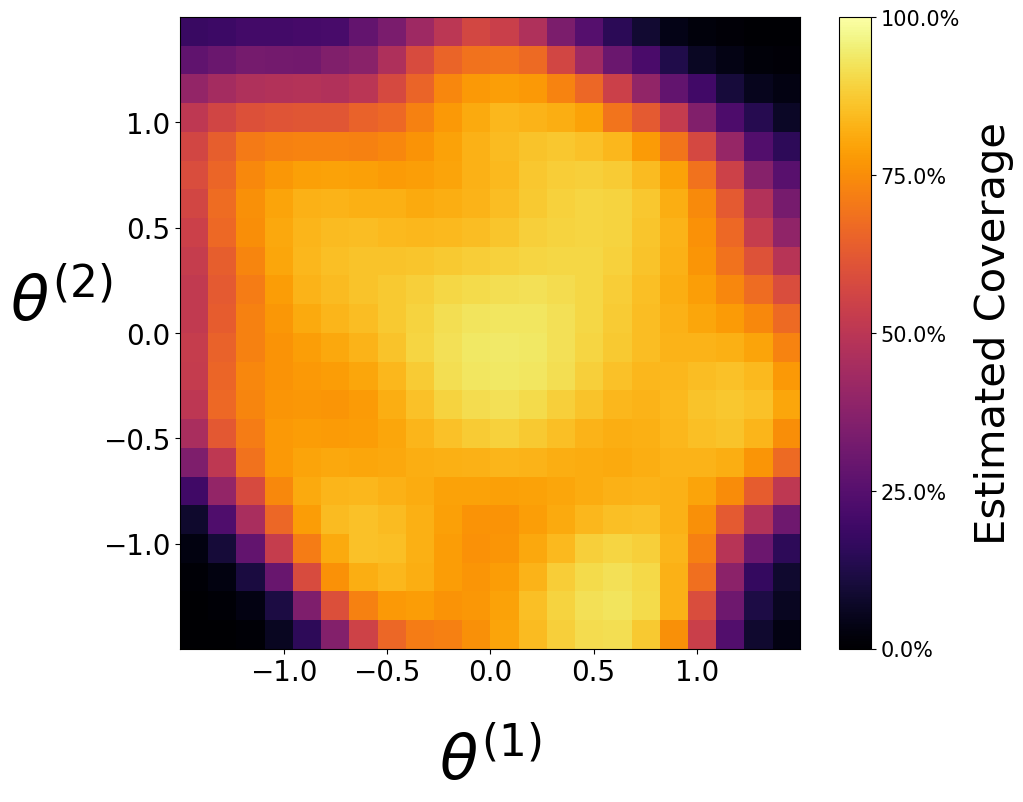
Waldo Confidence Regions#
Note that for this example we are using the simulator to obtain training datasets. If one has pre-simulated datasets, they can be given as inputs directly to the inference method.
diagnostic_estimator, parameters, mean_proba, upper_proba, lower_proba = lf2i.diagnostics(
region_type='lf2i',
simulator=simulator,
b_double_prime=10_000,
)
Approximating conditional mean and covariance for 20000 points...: 100%|██████████| 20000/20000 [13:21<00:00, 24.94it/s]
Coverage of Waldo is approximately \(90%\) everywhere, as desired
coverage_probability_plot(
parameters=parameters,
coverage_probability=mean_proba,
upper_proba=upper_proba,
lower_proba=None,
confidence_level=CONFIDENCE_LEVEL,
param_dim=PARAM_DIM,
figsize=(12, 10)
)
